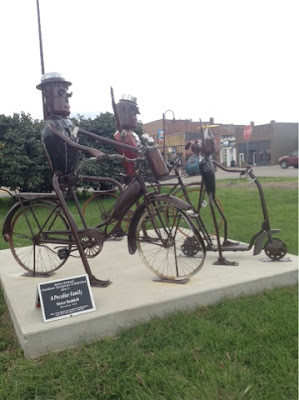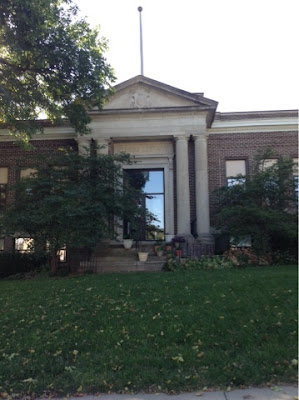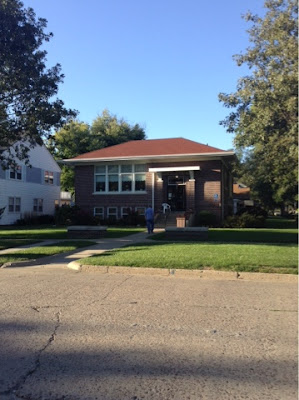I did learn a few things about cycling, the most startling of which was that Jacques Anqutil was blood doping back in the '60s while winning The Tour de France five times, or at least according to Eddie Borysewicz, coach of the 1984 US Olympic team that caused a national uproar when it was revealed by "Rolling Stone" magazine that it had blood doped. Johnson talked with the 77-year old dynamo and said, "his memory of the chain of events leading to blood doping is still clear." Blood doping was not against the rules at the time, but still a shady practice that was not widely practiced. Anquetil had always been open about his use of drugs, but I had never come across this admission. When I read this, I immediately emailed my friend the English cycling authority Les Woodland who has written over twenty books on racing, including one that Johnson footnotes, "The Crooked Path to Victory, Drugs and Cheating in Professional Bicycle Racing," to ask if he knew of this. He did not and doubted its veracity.
Borysewicz told Johnson he met Anquetil in the early '70s when he was visiting Jean Stablinski, another Tour veteran. He asked Anquetil how he sustained himself through the long racing season. He told him he always had two blood transfusions, one of which was before The Tour. It is shocking that Borysewicz didn't reveal this as part of his defense when "Rolling Stone" broke the story. Equally shocking is that if Borysewicz thought blood-doping was a means to success, why did he never introduce it to the Americans he was coaching, including Greg LeMond, until just before the Olympics, when there was an uncertainty of how the racers would react to the transfusions. And most shocking of all is that Johnson didn't pursue any of these issues.
But so it goes throughout this sprawling, rambling, unfocused discussion of doping that veers off onto tangents on the Puma/Adidas wars and Mormonism and the making of the Wizard of Oz (16-year old Judy Garland was doped!) and many others, bloating this 400-page book that would have been even fatter had not his publisher cut several chapters. Johnson can't seem to make up his mind what his point is or where he is going. One of his theses is that drugs were once accepted and that it was the professional thing to do, but then the time came that drugs became a scourge and those who resorted to them were considered pariahs. That's not entirely true. Anquetil was a rare exception to be open about it. When the Pelissier brothers revealed all the drug taking they did to the highly-respected investigative reporter Alfred Londres after they dropped out of the 1924 Tour de France it was a huge story. That doesn't fit in with Johnson's thesis, so he ignores it.
I had anticipated Jonathan Vaughters, head of the Garmin cycling team who made racing clean the foremost plank of his team, to be a prime source for this book. He knew him well from writing a book about his team. Vaughters is one of the smartest minds in the sport and raced during the EPO era and has spoken most articulately on his own dabbling with drugs, but he receives just one bare mention as someone who continually fretted about the drug issue. Vaughters thoroughly researched any drug before he used it, their safety and their effectiveness. He knew what a difference they could make. He could have enlightened Johnson on many issues. Vaughters set the record for the fastest time up Mont Ventoux until it was broken by Iban Mayo, but said it wasn't something he was proud of because it was drug-assisted. When Johnson came to Chicago's Garmin store in April of 2012 on his "Argyle Armada" book tour, I asked him if he had ever discussed the issue with Vaughters. It was a surprise he hadn't.
Rather than going into the trenches and asking riders about their quandaries and their reactions to drugs, he relies on academics for most of his information. His sources include Arthur Mandell, a psychiatrist who worked with the San Diego Chargers in the early '70s and wrote a book about it, "The Nightmare Season," Christopher Thompson, a professor at Ball State whose book "The Tour de France: A Cultural History" is footnoted sixteen times, and Dr. Charles Yesalis, a professor at Penn State who is a steroid expert.
He turns to the Spanish scholar Bernat López as his authority on EPO. He maintains that it is a myth that the rash of young cyclists dying in their sleep in the early '90s was related to EPO. He says it was media hype to discourage riders from taking the drug. He could have asked Bjarne Riis, who was known as "Mr Sixty Per Cent" for pushing the perceived hematocrit safe limit of fifty per cent, about how he decided how much to take and how the new drug was perceived by cyclists. EPO would thicken the blood and could clog the heart. He cites the famous quote of the Italian doctor Michele Ferari, who was Lance Armstrong's guru, comparing EPO to orange juice--"EPO is not dangerous. It's abuse is. It is also dangerous to drink ten liters of orange juice." That is an acknowledgement that it is a drug to be wary of, like all the drugs he traces in this book from amphetimimes to steroids.
He cites Chicagoan Danny Van Haute as an early blood doper. His father-in-law was a physician, so he had him perform the procedure preceding the trials for the 1984 Olympic team. He was flying faster than he ever had, qualifying for the pursuit team, turning a lot of heads. Van Haute has been the director of the domestic Jelly Bean team for years, the team that Phil Gaimon mentioned in his book "Pro Cycling on Ten Dollars a Day" whose doctor hinted to him that he had symptoms of asthm and that he could prescribe the popular medication among cyclists that would make him ride faster. Gaimon would have none of it. Van Haute would have made another good source for Johnson, but he too is ignored, as is the asthma issue. The Italian sprinter Alessandro Petacchi, who dominated the Giro d'Italia for several years, was suspended in 2007 for using excessive amounts of asthma medication. Rather than writing about the iffy morality of the many cyclists who claim to have asthma, Johnson writes about the similar thinking of the growing number of high school students who get doctors to diagnose them with ADHD, which allows them extra time when they take their SAT tests, enabling them to get higher scores and gain scholarships and entry to better colleges.
The longest of the book's twenty chapters is on the use of steroids in baseball and the national fascination with the McGuire/Sosa home run battle in 1998 to break Roger Maris' record of 61 home runs in a season. This embrace's Johnson's argument that spectators are complicit in the athlete's drug-taking. They had no issue with the bulked-up athletes for the entertainment they provided. Johnson doesn't know baseball as well as he knows cycling, as he referred to the early baseball commissioner Ford Frick as "George Frick." And he makes the outrageous claim that in 1996 Brady Anderson of the Baltimore Orioles hit a lead-off home run in twelve straight games. It was amazing enough that he did it in four straight games, as no one has ever done it more than twice.
Johnson's cycling commentary isn't without its mistakes as well. He wrote that Armstrong went on to be world champion after his recovery from "near-certain death" on page 351. He won the World Championship in Oslo in 1993. He was diagnosed with cancer after the 1996 Olympics. How his editors at Velo Press would let this slip by is unimaginable. It nearly discredits the entire book. Johnson also wrote that the French three-time winner of The Tour de France, Louisson Bobet, went on to become a journalist. It was his brother Jean who became a journalist. A quote from his book "Tomorrow We Ride" adorns a wall in Armstrong's bike shop in Austin. Johnson is also a year off on the year the head of the UCI Hein Verbruggen let Armstrong back-date his cortisone excemption in The Tour, writing that it happened in 2000, when it was the year before in Armstrong's first Tour win.
One myth that I was happy to have Johnson dispel is that the extreme demands of The Tour de France don't necessarily shorten a rider's life. The Scottish 1984 winner of the King of the Moutains Jersey Robert Millar maintains that one's life is shortened by one year for every Tour one rides. I often feel that way myself after riding The Tour route with my loaded touring bike, as I have done the past thirteen years. Johnson cites a French study that found the 786 French riders who raced The Tour from 1947 to 2012 had a 41 per cent lower mortality rate than the overall French population.
Johnson points out that is counter to the theory that all the drug-taking of the riders is detrimental to their health. At times it seems as if Johnson is defending, or at least condoning, the use of drugs. But he makes no suggestion, as some do, that there should be no restrictions. In his epilogue he concludes that drug taking should be restrained, if only to save the young. Even now ten percent of high school athletes jeopardize their health taking steroids and growth hormones. It would be much worse if it were made socially acceptable.
Johnson's bio on the book jacket identifies him as a category two racer. He avoids any mention of his time on the bike or anything personal other than that his wife and two sons "have had to listen to him rattle on for years about society's dual love affair with pharmaceuticals and sports." "Rattling on," for better or worse, is a good description for the book he wrote about the subject.








































